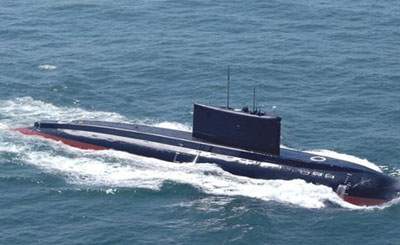(单词翻译:单击)
听力文本
This is Scientific American — 60-Second Science. I'm Christopher Intagliata.
In The Hunt for Red October, the Soviet submarine captain played by Sean Connery commands his crew to verify the location of a target. (MOVIE CLIP: "Give me a ping Vasily. One ping only please.")
That ping is known as "active sonar." Bob Headrick of the Office of Naval Research, the ONR, says it's the audio equivalent of switching on a flashlight. You're getting information back, but also broadcasting your location to other ships.
"And you know the number one priority in the submarine is to remain undetected." So subs can keep their secrecy by eavesdropping on other ships instead... listening for propellers and electronics and so on. Such methods, known as "passive sonar," generally require a skilled operator. But researchers are teaching machines to do it, too.
They first recorded the underwater rumblings of cargo ships off the California coast (ship sound) using an array of 28 underwater microphones. They fed that sound, along with the ships' actual GPS coordinates, to their machine learning algorithms. And then they gave the algorithms new recordings, and asked: where's the ship?

"And it did extremely well." Emma Ozanich, a PhD Student in underwater acoustics at the Scripps Institution of Oceanography. Using the audio data, she says the algorithms pinpointed the ships to within a couple hundred meters, at distances of up to 10 kilometers.
But it's not so clear what the machines now know. "One of the interesting parts about machine learning, especially neural networks, is that it's more difficult to pull out what it's actually learning specifically. It's a little bit of a black box." The research is in The Journal of the Acoustical Society of America.
Bob Headrick of ONR says the data set used here is relatively simple, compared to the real-world scenarios subs would have to solve. Still, he says, with lots more development: "You could conceive with enough effort you create the computer program that can beat the trained operator."
There is a precedent, after all, for machines defeating our best human operators. It was in that other great battle of the cold war: the game of chess.
Thanks for listening for Scientific American — 60-Second Science. I'm Christopher Intagliata.
参考译文
这里是科学美国人——60秒科学。我是克里斯托弗·因塔利亚塔。
在电影《猎杀红色十月》中,肖恩·康纳利扮演的苏联潜艇舰长命令他的船员去核实目标位置。(电影片段:“瓦西里,请再发出一声‘砰'。只要一声就行。”)
这声“砰”被称为“主动声呐”。美国海军研究办公室(简称ONR)的鲍勃·海德里克表示,这种声音相当于打开手电筒。你收到了信息反馈,同时也向其它船只公开了自己的位置。
“你知道,潜水艇的首要任务就是保持隐蔽。”潜水艇通过窃听其他船只来保持自身的隐蔽,而不是听螺旋桨、电子器件等发出的声音。这种方法被称为“被动声呐”,通常需要熟练的操作员来操作。但是研究人员也正在教机器这种操作方法。
他们首先用28个水下麦克风记录了加利福尼亚海岸附近的货船在水下发出的隆隆声(船只的声音)。 他们将录音连同船只的实际GPS坐标一起输入机器学习算法中。然后他们将新录音输入算法,询问船只位置。
“算法给出的位置极其准确。”斯克里普斯海洋研究所的水声学博士生艾玛·奥赞尼奇说道。她说,算法能利用这些音频数据定位10公里以内的船只,误差仅有几百米。
但目前尚不清楚机器现在知道些什么。“机器学习尤其是神经网络中有趣的一点是,了解其真正学到的东西更加困难。它有点儿像黑匣子。”这项研究结果发表在《美国声学学会期刊》上。
美国海军研究办公室的鲍勃·海德里克表示,研究中使用的数据集相对比较简单,相比之下,现实情况中潜水艇要解决的问题则更加复杂。不过他认为,随着发展的不断进步:“你可以设想,我们能用足够的努力创造出可以击败专业操作员的电脑程序。”
毕竟,机器打败我们人类最优秀的操作员是有先例的。那发生在冷战的另一场伟大战役中:国际象棋。
谢谢大家收听科学美国人——60秒科学。我是克里斯托弗·因塔利亚塔。
译文为可可英语翻译,未经授权请勿转载!
重点讲解
重点讲解:
1. switch on 打开,开启(电灯等);
例句:He didn't bother to switch on the light.
他懒得去开灯。
2. eavesdrop on 偷听;窃听;
例句:Some journalists will always try to eavesdrop on the private conversations of the Royal family.
有些记者总想设法偷听皇室成员的私下交谈
3. and so on 及诸如此类;等等;
例句:Consumer durables such as refrigerators, television sets, bicycles and so on were produced in large quantities.
冰箱、电视、自行车等耐用消费品被大批量地生产出来。
3. after all 毕竟;终究;
例句:There is no need to pick at him all day long. He's a child after all.
不要老是对他唠唠叨叨,他毕竟还是个孩子嘛!


